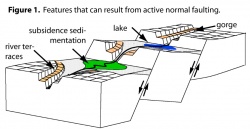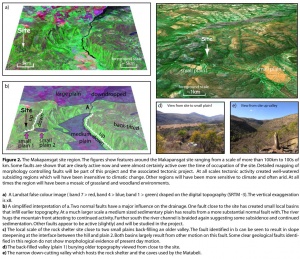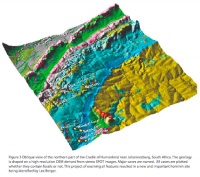ProjectA1
From !khure
Project A1:
Tectonic geomorphology and climatic influence on Plio-Pleistocene hominin environments in southern Africa
French pi: G. King
South African pis: Paul Dirks, Lee Berger
Project Participants:
- Prof. Geoffrey King Tectonique Laboratory, Institut de Physique du Globe de Paris, France
- Prof. Paul Dirks School of Geosciences, University of the Witwatersrand, Johannesburg, South Africa
- Prof. Lee Berger Institute for Human Evolution, University of the Witwatersrand, Johannesburg, South Africa.
- Dr Anne-Sophie Meriaux Department of Geography, University of Newcastle,UK.
- Dr Dan Farber University of California Santa Cruz Earth and Planetary Science Dept., USA
Project Associates:
- Dr Sally Reynolds Tectonique Laboratory, Institut de Physique du Globe de Paris, France
- Prof. Geoff Bailey Department of Archaeology, University of York, York, U.K.
- Prof. Julia Lee-Thorp Division of Archaeological, Geographical and Environmental Sciences, University of Bradford, UK, and Africa Earth Observation Network, South Africa.
Background
A central research area in the study of human evolution is assessing the role and extent that climatic shifts and habitat changes have played in the emergence of our own species, Homo sapiens. South Africa has highly fossiliferous deposits from this important temporal period, starting with the appearance of Australopithecus africanus at sites such as Taung, Makapansgat and Sterkfontein at around 3Ma. From these and other sites, it is possible to build up a semi-sequential, and highly informative record of the faunal, floral and hominin changes, up until the earliest members of our own species appear at sites such as Hofmeyr (Grine, Bailey et al. 2007) and evidence of behavioural modernity at Blombos Cave.
Although the sites have been subject to much excavation and site-specific analysis, broader interpretations of regional environmental conditions are often simply extrapolated from site-specific datasets, based on the standard assumption that these individual sites are representative of larger geographic areas. This appears defensible for large-scale patterns, such as climatic cooling and aridification of Africa (e.g. deMenocal 2004), which precipitated the spread and intensification of C4 grasses across certain regions of southern Africa, but other patterns influence smaller regions in specific, and important ways. One such influence is tectonic activity, which can alter drainage, sedimentation, topography and vegetation on much smaller scales. Furthermore, tectonic activity causes uplift and subsidence, resulting in localised regions of steep, uplifted topography (kloofs, steep valleys, river gorges) and also areas of subsidence (fertile plains, swamps and lakes). This results in the creation and maintenance of topographically influenced ‘mosaic’ environments, which King and Bailey (2006) have argued to be important, preferred landscapes for early and later hominins. Figure 1 shows schematically how active, normal faulting creates these landscape features.
In this project, we seek to bring together several techniques to explore 1) constraints on hominin landscape use and range sizes, derived from a combination of geomorphological reconstructions versus strontium isotope sourcing information, based on a study already underway in the Cradle of Humankind (Sterkfontein region) and 2) to characterise the neotectonic control on landscape features at long-occupation sites in particular Sterkfontein and Makapansgat, and extending this to other important hominin sites in southern Africa which show clear signs of tectonic changes to the geomorphology, such as Taung, Florisbad and Boomplaas Cave.
Makapansgat Valley sites – an illustration of the approach to be taken at Sterkfontein, Taung, Florisbad, Boomplaas Cave
The methodology can be illustrated for the Makapan Valley region, where a series of caves in a single valley have been exploited by hominins from at least 3 Ma to the present day. These sediments contain pre-stone tool-using Australopithecus africanus, while later deposits boast a complete cultural sequence (Early, Middle, Later Stone Ages as well as Iron Age tool industries), preserved with archaic Homo heidlbergensis and our own species Homo sapiens. Later, the steep, rugged terrain around the Historic Cave (in the same valley) was exploited by the Ndebele tribes-people during their uprising against the Boers in 1845, because the protection it afforded. In the same manner, earlier hominins may have found relative safety from large, cursorial predators. This feature, combined with sufficient food and sources of water, could explain why this site was repeatedly used by hominins over millions of years.
Figure 2 provides a simplified interpretation of the region around the site to illustrate the tectonic features to be examined. Figure 2a shows a Landsat Image draped over SRTM3 digital topography. Figure 2b interprets some important features of the image. Two faults (white) can be identified that have a controlling influence on the regional morphology and hydrology. In the background subsidence has occurs at the edge of the large plain. This causes the river to form braided channels and the river sediments are now exploited for farming. In the middle distance a medium-sized plain results from a normal fault that down-drops the valley and uplifts and back-tilts the ridge. Continued activity on the fault causes the river to hug the escarpment. Approaching the site, a second fault showing slope steepening at the interface between the hills and the plain (evidence of ongoing tectonic activity) creates some smaller backfilled valleys (Figure 2b) that can be see in more detail in Figure 2c. For the immediate site region this produces features commonly observed close to other sites of long-term occupation (King and Bailey 2006). Figure 2d shows the flat depositional plain that results from refilling an earlier valley with sediment and Figure 2e viewed towards the hills from the site shows the river down-cutting that produced the severe topography that prevented Boers from storming the Ndebele stronghold.
The object of the study for the Makapans Valley will be to examine which features may have made this region so preferable for hominins and humans. Geological and soil distributions, combined with climate modelling (Fred Fluteau) will enable us to reconstruct the environments as they where at various times during the last 3 million years. A resolution of 50 km is now possible.
In due course use edaphic studies combined with palaeontological data will be used to place predators and prey on the landscape, in the manner done by Geoff Bailey and collaborators in Greece (Bailey 1997). These patterns, when meaningfully inter-related, will characterise the relationship of hominins to their landscape, and to the overall mammalian community, which included extinct sabre-toothed cats, extinct primates and many antelope species represented found in the region (Reed 1997; Sponheimer, Reed et al. 1999). The active faults need to be fully identified from geomorphological features and their rates determined or estimated by dating offset surfaces or fans and this section of our project strongly complements the tectonic !Khure project (Evolution of African rift propagation into Southern Africa).
Sterkfontein, Taung, Florisbad, Boomplaas Cave.
All significant South African sites have been identified and examined using Satellite images and digital topography. A process not entirely straightforward since experience has shown that quoted site coordinates can be 10’s of km from the true site. Four sites will be subject to more thorough field studies in the next phase of the project: Sterkfontein, Taung, Florisbad, Boomplaas Cave. These studies will be carried out in collaboration with Wits School of Geosciences and the Transvaal Museum. Of particular relevance the seismicity and hence active tectonics of the Sterkfontein region will be carried out with the Wits seismologists who are already engaged in a project to distinguish between mining induced and natural seismicity – a central question to establishing features of the active morphology of the Cradle of Humankind region.
The Cradle of Humankind – data base
The philosophy of the project is to examine regions that are much larger than a kilometer or two around a fossil site. A site indicates that hominins were in the region, but must have been in substantial numbers to form a stable breeding population. To pursue this approach a separate project was initiated slightly before !Khure to study the region of Northern Israel (The Galilee project) which has attracted hominins from 1.8 Ma to the present and for which some of the most extensive historical and pre-historical data is available. On this basis Lee Berger and Geoffrey King started a similar database for the Cradle of Humankind. This aims to map all cave sites, with or without fossils, tool scatters, and resources such as springs. These together with later information of hominin and human occupation are to be combined in an interrogate-able data base operating interactively with maps showing various resources, satellite photographs and so forth (Figure 3). As consequence of this project Lee Berger discovered a new hominin site (Dirks et al 2009) which promises to be of major importance and will be officially announced in June 2009.
The Cradle of Humankind – landscape evolution
The landscape in the Cradle has been thought to be tectonically stable, with little change having occurred in the past several million years, other than change driven by climatic variations. Yet, the plains of southern and eastern Africa occur at an anomalously high altitude, with at least 2 to 3 km of uplift of the land surface having occurred over the past 27 million years. The geological reasons for this uplift are not well understood, but uplift is likely to be linked to anomalous mantle flow below the African plate. The rate of uplift in the past several million years remains unconstrained, but it is probable that the altitude of the land surface around the Cradle has changed over this period by possibly as much as several hundred meters. Uplift of the Cradle in the past 3 million years, will have caused activity on faults and fractures that in turn controlled cave formation, ground water flow as well as the formation of the incised plateau topography characteristic for the area. This happened as Hominins actively occupied the landscape, and their evolution and use of the land surface is therefore linked to the manner in which the land surface developed. In a similar manner the preservation of their fossil remains in the cave systems is a direct function of the geological controls and the rate of uplift and erosion of the land surface. The aim of this project is to unravel the evolution of the land surface in central South Africa as exposed in the Cradle of Humankind in relation to known fossil-bearing sites, and to establish whether a causal link exists between hominin and landscape development.
Relevant References
- Bailey, G. N. (1997). Klithi: Palaeolithic settlement and Quanternary landscapes in northwest Greece. Cambridge, McDonald Insitute Monographs.
- deMenocal, P. B. (2004). "African climate change and faunal evolution during the Pliocene-Pleistocene." Earth Planet. Sci. Lett. 220: 3 - 24.
- Grine, F. E., R. M. Bailey, et al. (2007). "Late Pleistocene human skull from Hofmeyr, SouthAfrica, and modern human origins." Science 315: 226 - 229.
- King, G. C. P. and G. N. Bailey (2006). "Tectonics and human evolution." Antiquity 80: 265 - 286.
- Reed, K. E. (1997). "Early hominid evolution and ecological change through the African Plio-Pleistocene."J. Hum. Evol. 32: 289 - 322.
- Sponheimer, M., K. E. Reed, et al. (1999). "Combining isotopic and ecomorphological data to refine bovid paledietary reconstruction: a case study from the Makapansgat Limeworks hominin locality." J. Hum. Evol. 36: 705 - 718.
Submitted Papers
- King, G. C. P. and G. N. Bailey (2009). Dynamic landscapes and human evolution. Geological Society of America Bulletin. in review.
- Bailey, G. N ., Reynolds, S. C. and King, G. C. P. (2009). Tectonic geomorphology and hominin landscapes: models, methods and hypotheses. Journal of Human Evolution. in review
- Dirks, P. H. G. M, J. M. Kibii, B. Kuhn, C. Steininger, S. E. Churchill, D. L. Farber, G. C. P. King and L. R. Berger (2009). Geological setting of the first associated skeletons of early Homo from southern Africa, Nature. in review.






